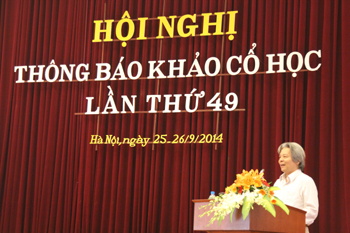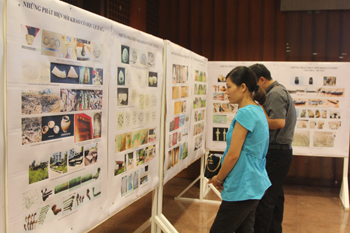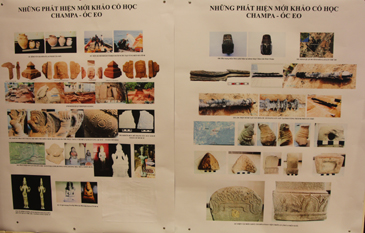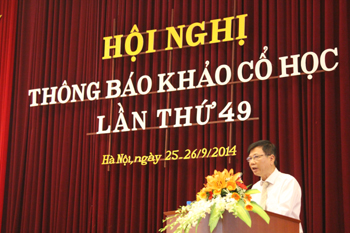|

|
Prof.Dr. Vo Khanh Vinh, Vice President of VASS had a opening speech |
|
Speaking to welcome the Conference, Prof.Dr. Vo Khanh Vinh, Vice President of VASS warmly welcomed the presence of the delegates, highly appreciated the annual organization of the Conference as well as the obtained achievements of archeological sector in providing the important, objective foundations about the national development history (through the cultural heritages such as Imperial Citadel of Thang Long (Hanoi), Ho Dynasty Citadel (Thanh Hoa), Trang An (Ninh Binh)... Besides, the professor, Vice President of the VASS also stressed the importance of expanding the research cooperation of the archeological sector and special position of the underwater Archaeology and judged that: This field is not new to the archeological sector of the world, but it has a great significance, contributes to expanding the research space, providing effective support for the scientific research, reconnaissance, mapping underwater... in order to seek the cultural values, affirm the sea and island sovereignty, protect and develop the country in general.At the Conference, Dr. Bui Van Liem, Deputy Director of the Institute of Archaeology said: The organizing board received 472 papers from the local and foreign authors. The number and content of archaeological announcements followed closely the major research programs; Excavations, investigations, explorations, reconnaissance, along with the findings, diversified and copious researches on relics and monuments that supplemented many new documents for the archeological sector, history, culture…. From that, it also contributes effectively to building records, planning, protection, restoration and promotion of the values of relics and heritage in the contemporary life.

|
|

|
|
Panorama of the Conference |
|
TDelegates visit the exhibition area
"Announcement of new objects on display" |
More text goes here.More text goes here.The Conference was divided into four panels: (1) Stone Age archaeology (by Dr. Nguyen Gia Doi, Assoc.Prof.Dr. Han Van Khan, co-heads of the panel); (2) Metal Age archaeology (by Dr. Trinh Hoang Hiep, Assoc.Prof. Dr. Bui Chi Hoang, co-heads of the panel); (3) Historical archaeology (by Dr. Le Dinh Phung, Dr. Pham Quoc Quan, co-heads of the panel); (4) Champa - Oc Eo archaeology (by Dr. Nguyen Tien Dong, Assoc.Prof.Dr. Ngo Van Doanh, co-heads of the panel).
For the Stone Age Archaeology , the Organizing Board received 57 papers, typically the coordination between the Institute of Archaeology with the other units such as:
- Together with the Department of Culture, Sports and Tourism, Lai Chau Museum to excavate, remove 7 locations and collect the objects on display at the two archaeological locations distributed in two districts Muong Te and Nam Nhun. The excavation result provides a lot of valuable scientific documents, contributes to researching the history of Lai Chau in particular and the Northwestern region in general.
- Together with Son La Museum in surveying Tham Bo Cave, discovered the cultural stratum and obtained relics such as: dressing and hacking tools, ax with whole body sharpening, stripping pieces, material rock, ceramics, vestiges of mollusca shell and fruit, grain showed that Tham Bo Cave is the residence of inhabitants at the Neolithic Age, aged about 7000 to 4000 years ago. At Ban Mon archeological site, discovered stone things, potteries and animal bones and teeth, this is the archeological site - manipulating workshop for quadrilateral ax and bracelets with the earliest sawing and drilling technique in the Northwestern region. Many other activities such as reconnaissance at Ma Trang cave, Thuy Son commune, Ngoc Lac district, Thanh Hoa, the scientists also discovered a lot of stripping pieces and fossil bones dated about ten thousand years ago... These excavation results and new findings supplemented the valuable document sources for the Stone Age Archaeology.

|
|

|
|
New findings of Stone Age Archaeology |
|
New findings of Champa - Oc Eo Archaeology |
More text goes here.Metal Age Archaeology includes 48 papers, describing the diversified and copious research activities: The Department of Archaeology and Anthropology Museum, University of Social Sciences and Humanities (Vietnam National University, Hanoi) coordinated with Hanoi Museum to excavate Vuon Chuoi relic for the 7th time; The Institute of Archaeology coordinated with the Department of Culture, Sports and Tourism, Long An Museum to excavate Go Duoi archeological site for the first time. The reconnaissance in Con Coc (Ha Tinh) found out about the relationship with Con Nen relic (system of relics has red colored potteries) and Go Diep, Vinh Hai, Suoi Cam relics (Khanh Hoa) contributed more the documents learning about the relationship with Xom Con culture with the prehistory in Khanh Hoa.
The bronze drum and collections of Dong Son cultural objects on display are still the special subjects that are discovered and discussed quite effervescently at the metal subcommittee. The findings and drum research in Vietnam in the provinces such as Son La, Lai Chau, Thanh Hoa and outside Vietnam such as in Cambodia, Laos, China, the collection of relics discovered in Lao Cai, Tuyen Quang, Ninh Binh, Thanh Hoa, Nghe An, or at the private museums supplemented to Hego drum collection (types I and II) and Dong Son bronze relics which were very copious.
Besides, the new researches on pottery of Phung Nguyen, Duong Xa culture, Gio pagoda mold; unique Dong Son statue mass in the collection in Hanoi; Bac Ninh tomb date; Ninh Thuan gourd pottery, Lo Gach knitting in Long An, strange objects on display in Binh Duong also received many effervescent comments and discussion from the attenders.
Historical Archaeology received 239 papers, focusing on the following typical activities: Thang Long - Ha Noi Heritage Conservation Center and the Institute of Archaeology excavated Kinh Thien Palace relic site from the architectural vestiges and relics that are determined clearly the cultural layer continuously from Dai La Dynasty through Ly, Tran, Later Le, Le Trung Hung Dynasty to Nguyen Dynasty.
The Institute of Archaeology, Hanoi Department of Culture, Sports and Tourism excavated O Cho Dua intersection area and discovered the vestige and relics of the different eras Tran - Le - Nguyen; Ho Chi Minh Relic Conservation Center coordinated with the City Museum of History, University of Social Sciences and Humanities excavated the ancient tombs in the precinct of An Khanh communal house. The result showed that, the plan and architectural structures of the ancient tomb are relatively common in the Southern part and belongs to the form of compound tomb for the upper strata, dated about the first half of the nineteenth century.
The investigation, reconnaissance activities in Lu Citadel (Cao Bang), Bau Dynasty Citadel (Tuyen Quang), Co Long Citadel (Nam Dinh) and the obtained after learning about the position, scale, structure of Van An Citadel (Nghe An)... supplemented to the previous researches on the early and continuous presence of inhabitants at the Central metal age as well as of the Vietnamese in the history of Vietnam at Ly - Tran - Le - Nguyen dynasty. In addition, the subcommittee also had a lot of announcements about the relics, vestiges discovered in the temples, pagodas, shrines, temples, temples of literature, Sino-Chinese transcribed Vietnamese documents, epitaphs, conferred titles, coins, potteries... contribute to enriching the archaeological information of Vietnamese history through the age landmarks of the nation.
Champa - Oc Eo Archaeology, underwater archaeology received 33 papers about the activities as follows: Archaeology Center, Institute of Southern Social Sciences coordinated with Ninh Thuan Department of Culture, Sports and Tourism excavated for the 3rd time Hoa Lai relic. The excavation result exposed the gate tower, cultural foundation of the Northern tower complex, middle and southern towers, high wall system. This result supplemented a lot of research documents of Hoa Lai relic in particular and architecture, sculpture in the history - culture of Champa. The Department of Archaeology, Faculty of History, Hanoi University of Social Sciences and Humanities coordinated with the Faculty of History, Hue University of Sciences to conduct a survey of Loi Citadel. The survey result showed that the discovered pieces of tile and pottery have many characteristics of coarse, fine pottery, tile of Champa belonging to the upper cultural layer of Tra Kieu, i.e. from after the 4th - 5th century.
The scientists exchanged much around the research on building techniques of ramparts and walls in Loi Citadel (Thua Thien Hue), Man Tower relics (Binh Dinh), different and uncommon point in the architecture Champa temple and tower group of Go village, Kuts statue (Binh Thuan), collection of the sound Bodhisattva, Indochina Buddha Statue, Nadin cow statue in Oc Eo culture, Siva god, Hara god, Garuda god (Ho Chi Minh city), coconut traces in the archeological site of Go Minh Su God pond (Dong Thap), An Giang Floating Stone archeological site...
Besides, the panel also gave the special attention to the announcements about the underwater Archaeology - a new field in Vietnam, but there are quite exciting activities such as: The Institute of Archaeology coordinated with the Management Unit of key relics of Quang Ninh to survey the traces of Van Don trading port, with purpose to learn about the duration of existence and commercial traces and building mapping system. The archeological experts of Australia, Canada, cadres of the Institute of Archaeology, Nghe An Museum conducted the archeological survey to find the trace of the ship wrecked on Lam river (Nghe An). The survey, research activities of sea cultural heritage in Quang Ninh, Ha Tinh by the foreign scholars (Japan) increased the attractiveness of underwater Archaeology and received many exchanges from the attenders.
|

|
Assoc.Prof.Dr. Nguyen Giang Hai, Director of the Institute of Archaeology gave the conclusion speech at the Conference |
|
Speaking for summarization, Assoc.Prof.Dr. Nguyen Giang Hai, Director of the Institute of Archaeology congratulated the success of the Conference and said that, the issues raised in the announcements at the subcommittees will become the research direction for the next year. In order that the researches and achievements of the Archaeological sector can go into the depth and be more meaningful in the coming period, The Institute of Archaeology in particular, the archeological sector of the whole country in general will have the breakthrough steps to affirm the great value of the archeological sites, relics as well as significance of the archeological sector for the historical process, cultural - social development of home country. Such breakthroughs will be strengthened especially for the underwater archaeology , expand the research area in Spratly IslandTruong Sa and the research cooperation projects with the localities in the whole country to seek the vestiges, relics, materials… with value to affirm the development history of the nation, directing to welcome the 50th Archeological Announcement Conference that will be held in Hue in the mid-September 2015.
Pham Vinh Ha







